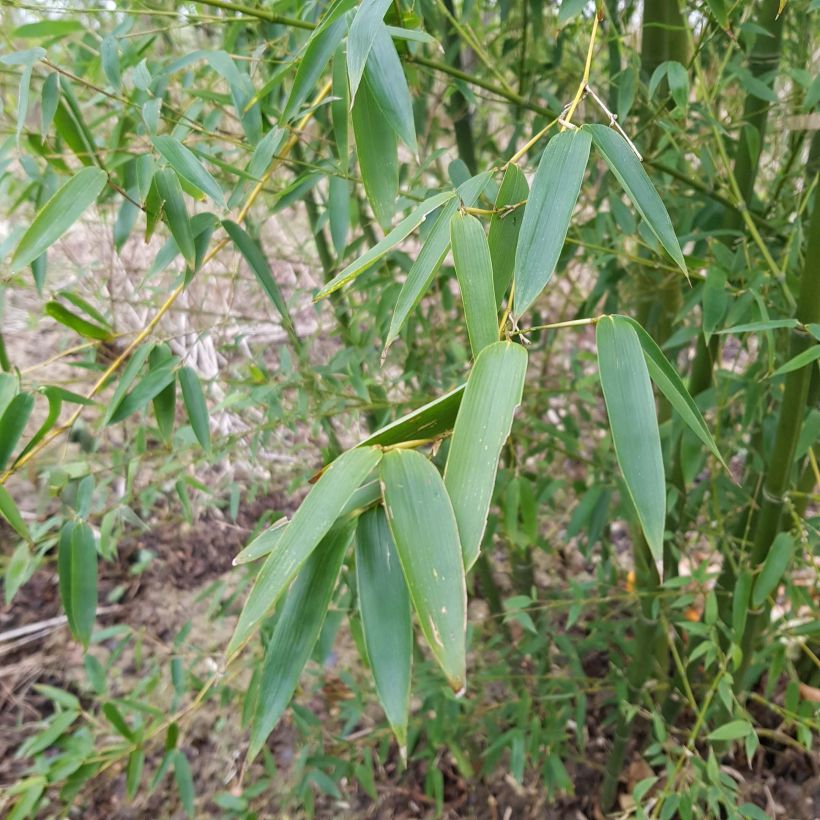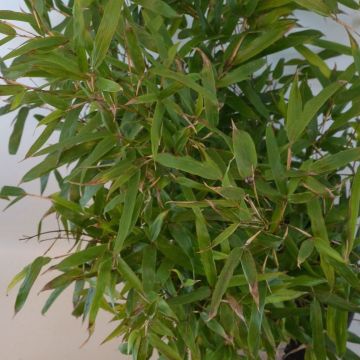

Phyllostachys parviflora - Giant Bamboo


Phyllostachys parviflora - Giant Bamboo


Phyllostachys parviflora - Giant Bamboo
Phyllostachys parviflora - Giant Bamboo
Phyllostachys parviflora
Giant Bamboo
Good young plants
Carole, 30/09/2023
Special offer!
Receive a €20 voucher for any order over €90 (excluding delivery costs, credit notes, and plastic-free options)!
1- Add your favorite plants to your cart.
2- Once you have reached €90, confirm your order (you can even choose the delivery date!).
3- As soon as your order is shipped, you will receive an email containing your voucher code, valid for 3 months (90 days).
Your voucher is unique and can only be used once, for any order with a minimum value of €20, excluding delivery costs.
Can be combined with other current offers, non-divisible and non-refundable.
Home or relay delivery (depending on size and destination)
Schedule delivery date,
and select date in basket
This plant carries a 24 months recovery warranty
More information
We guarantee the quality of our plants for a full growing cycle, and will replace at our expense any plant that fails to recover under normal climatic and planting conditions.
Would this plant suit my garden?
Set up your Plantfit profile →
Description
Phyllostachys parviflora, whose Chinese name is "Anji golden bamboo," is a very hardy giant bamboo, well adapted to wet soils and cold climates. It is distinguished by its small, irregularly arranged leaves, which give it a characteristic, light, airy, and charming appearance. It is a vigorous bamboo with trailing rhizomes, with fairly rapid but less explosive growth than its cousin Phyllostachys vivax. Its young shoots are yellow-striped, and its young canes, thick and sturdy, adorned with rings covered in clear bloom, are light green with purple stripes. This infinitely graceful bamboo works wonders near water or in a large isolated clump in a big garden.
Native to China, in the mild climate provinces of Zhejiang, not far from Hangzhou, and the Anji region, Phyllostachys parviflora is a vigorous bamboo that seems very resistant to cold. It has trailing roots, and its rhizomes have air channels that allow it to tolerate very wet, marshy, or occasionally flooded soils. It belongs to the family of poaceae (or grasses), it is a kind of giant grass with woody stems.
It has an erect habit and bears short, leafy, rather upright branches. The rootstock produces young shoots in June-July, more or less numerous depending on the year. They are oblique, javelin-shaped, covered with a purple sheath on which yellow stripes quickly appear. These shoots release canes or culms 6 to 7cm (2 to 3in) in diameter with a fairly thick wall, resistant to strong winds. They can grow several centimetres per day and reach a height of 7 to 8m (23 to 26ft). Each cane is light green, the internodes are crossed by fine purple stripes, and the nodes are covered with a nearly white bloom. As they age, the canes turn grey. The evergreen foliage consists of small narrow leaves measuring 4 to 6cm (2in) long and 8mm (1/2in) to 1.2cm (1in) wide. They are bright light green in colour. Perfectly hardy, this bamboo can withstand temperatures as low as -20°C. However, in case of snowfall, remember to shake the canes to remove the snow. This species particularly dislikes limestone soils and is quite difficult to propagate by dividing the rootstock.
As the undisputed star of Asian-inspired gardens, giant bamboo suits many styles, from contemporary to exotic, natural gardens or water gardens. Planted in mass, it quickly creates very exotic forests, and its graphic design brings verticality to the decor. Its fast growth makes it an excellent candidate to mask an unsightly view, especially if it is planted in fertile and moist soil. Its presence is such that you can plant it as a standalone clump. However, in a flower bed, its unique style can be difficult to match. Try, for example, to associate it in an exotic setting with other giants such as Gunnera manicata or Hosta 'Big Daddy', a large Rhododendron if your soil and climate allow it. Bamboos complement each other very well, so choose varieties with differently coloured culms. They are always perfect near water, as they seek freshness. A large avenue bordered on both sides by Phyllostachys parviflora will become a royal avenue.
The young shoots of this bamboo, harvested when very young, are edible and highly prized by gourmets.
Report an error about the product description
Phyllostachys parviflora - Giant Bamboo in pictures




Plant habit
Foliage
Botanical data
Phyllostachys
parviflora
Poaceae
Giant Bamboo
China
Other Phyllostachys
View all →Planting and care
Grown in containers, bamboo can be planted at any time of the year, except during frost. However, the best planting period is late summer and autumn, when the soil is warm and rainfall is more frequent. The planting distance depends on how you will use your bamboo: for a mass planting, allow a spacing of 3 to 4 metres (10 to 13 feet) between each plant. For a hedge, this distance is reduced to 1.6 to 2 metres (5 to 7 feet).
In general, bamboo prefers rich, deep, well-drained soil that remains moist, acidic or neutral. They can tolerate slightly alkaline soil, depending on the variety. Phyllostachys parviflora is sensitive to alkaline and dry soil. It enjoys sunlight but can tolerate partial shade.
During planting, make sure to loosen the soil and moisten the root ball well by soaking it. You can add well-decomposed compost and rake it into the surface. Watering should be done regularly, especially during the first year in the ground and continuously if your bamboo is grown in a pot. The establishment period may seem a bit long, but don't panic!
For bamboo with spreading rhizomes, it is essential to install a rhizome barrier (thick and sturdy polypropylene film) because these varieties, which disregard property boundaries, can quickly colonize large areas. The rhizome barrier should be buried vertically, leaving a height of 10cm (4in) above ground and inclined at a 15° angle towards the plant.
In terms of maintenance, bamboo is not demanding: remember to weed around the base, at least initially, until the dead leaves on the ground form a natural mulch. An application of nitrogen-rich fertilizer (well-decomposed manure or liquid fertilizer) in spring and autumn can be beneficial.
Planting period
Intended location
Care
-
, onOrder confirmed
Reply from on Promesse de fleurs
Similar products
Haven't found what you were looking for?
Hardiness is the lowest winter temperature a plant can endure without suffering serious damage or even dying. However, hardiness is affected by location (a sheltered area, such as a patio), protection (winter cover) and soil type (hardiness is improved by well-drained soil).

Photo Sharing Terms & Conditions
In order to encourage gardeners to interact and share their experiences, Promesse de fleurs offers various media enabling content to be uploaded onto its Site - in particular via the ‘Photo sharing’ module.
The User agrees to refrain from:
- Posting any content that is illegal, prejudicial, insulting, racist, inciteful to hatred, revisionist, contrary to public decency, that infringes on privacy or on the privacy rights of third parties, in particular the publicity rights of persons and goods, intellectual property rights, or the right to privacy.
- Submitting content on behalf of a third party;
- Impersonate the identity of a third party and/or publish any personal information about a third party;
In general, the User undertakes to refrain from any unethical behaviour.
All Content (in particular text, comments, files, images, photos, videos, creative works, etc.), which may be subject to property or intellectual property rights, image or other private rights, shall remain the property of the User, subject to the limited rights granted by the terms of the licence granted by Promesse de fleurs as stated below. Users are at liberty to publish or not to publish such Content on the Site, notably via the ‘Photo Sharing’ facility, and accept that this Content shall be made public and freely accessible, notably on the Internet.
Users further acknowledge, undertake to have ,and guarantee that they hold all necessary rights and permissions to publish such material on the Site, in particular with regard to the legislation in force pertaining to any privacy, property, intellectual property, image, or contractual rights, or rights of any other nature. By publishing such Content on the Site, Users acknowledge accepting full liability as publishers of the Content within the meaning of the law, and grant Promesse de fleurs, free of charge, an inclusive, worldwide licence for the said Content for the entire duration of its publication, including all reproduction, representation, up/downloading, displaying, performing, transmission, and storage rights.
Users also grant permission for their name to be linked to the Content and accept that this link may not always be made available.
By engaging in posting material, Users consent to their Content becoming automatically accessible on the Internet, in particular on other sites and/or blogs and/or web pages of the Promesse de fleurs site, including in particular social pages and the Promesse de fleurs catalogue.
Users may secure the removal of entrusted content free of charge by issuing a simple request via our contact form.
The flowering period indicated on our website applies to countries and regions located in USDA zone 8 (France, the United Kingdom, Ireland, the Netherlands, etc.)
It will vary according to where you live:
- In zones 9 to 10 (Italy, Spain, Greece, etc.), flowering will occur about 2 to 4 weeks earlier.
- In zones 6 to 7 (Germany, Poland, Slovenia, and lower mountainous regions), flowering will be delayed by 2 to 3 weeks.
- In zone 5 (Central Europe, Scandinavia), blooming will be delayed by 3 to 5 weeks.
In temperate climates, pruning of spring-flowering shrubs (forsythia, spireas, etc.) should be done just after flowering.
Pruning of summer-flowering shrubs (Indian Lilac, Perovskia, etc.) can be done in winter or spring.
In cold regions as well as with frost-sensitive plants, avoid pruning too early when severe frosts may still occur.
The planting period indicated on our website applies to countries and regions located in USDA zone 8 (France, United Kingdom, Ireland, Netherlands).
It will vary according to where you live:
- In Mediterranean zones (Marseille, Madrid, Milan, etc.), autumn and winter are the best planting periods.
- In continental zones (Strasbourg, Munich, Vienna, etc.), delay planting by 2 to 3 weeks in spring and bring it forward by 2 to 4 weeks in autumn.
- In mountainous regions (the Alps, Pyrenees, Carpathians, etc.), it is best to plant in late spring (May-June) or late summer (August-September).
The harvesting period indicated on our website applies to countries and regions in USDA zone 8 (France, England, Ireland, the Netherlands).
In colder areas (Scandinavia, Poland, Austria...) fruit and vegetable harvests are likely to be delayed by 3-4 weeks.
In warmer areas (Italy, Spain, Greece, etc.), harvesting will probably take place earlier, depending on weather conditions.
The sowing periods indicated on our website apply to countries and regions within USDA Zone 8 (France, UK, Ireland, Netherlands).
In colder areas (Scandinavia, Poland, Austria...), delay any outdoor sowing by 3-4 weeks, or sow under glass.
In warmer climes (Italy, Spain, Greece, etc.), bring outdoor sowing forward by a few weeks.


















































